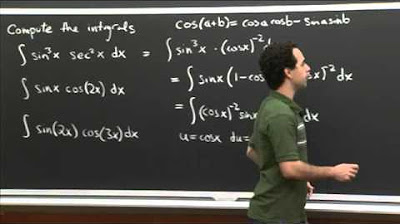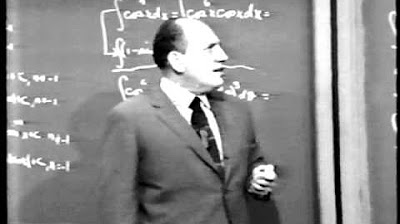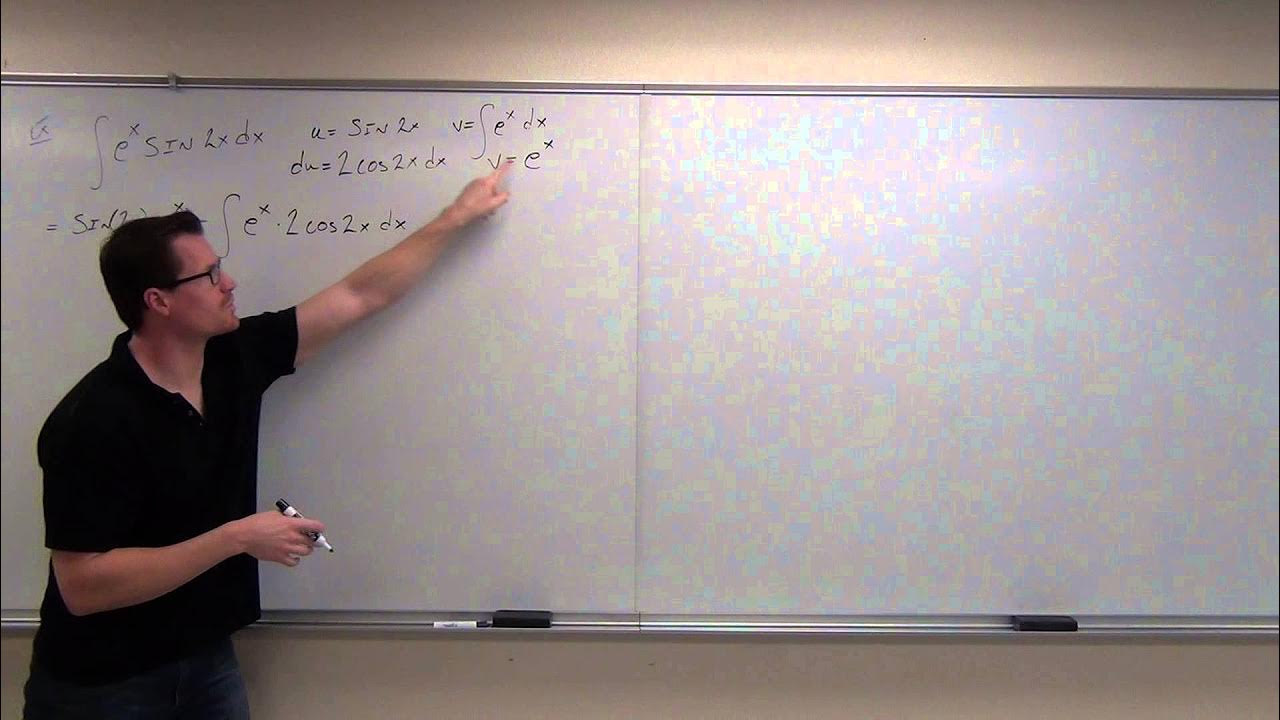Calculus Chapter 3 Lecture 23 Trig Substitution
TLDRIn this calculus lecture, Professor Gist explores the art of trigonometric substitutions in integral calculus, focusing on simplifying complex expressions. The professor demonstrates various examples, including integrals involving tangent and secant functions, and highlights the importance of recognizing patterns and utilizing trigonometric identities. The lecture also touches on hyperbolic trigonometric functions and the utility of algebraic simplification in identifying suitable substitutions. The goal is to transform challenging integrals into manageable forms, providing students with a deeper understanding of integration techniques.
Takeaways
- 🔢 Trigonometric substitutions can simplify complex integrals, transforming them into more manageable forms.
- 🔄 This method involves substituting a trigonometric function for a variable, using known identities to simplify the expression.
- 🔎 The example of integrating 1/(1 + x^2) involves the substitution x = tan(θ), leading to a simpler integral of dθ.
- 📏 Knowing trigonometric identities like sin^2(θ) + cos^2(θ) = 1 is crucial for making these substitutions effectively.
- 📚 Hyperbolic trigonometric functions also play a role in simplifying certain types of integrals.
- 📐 Completing the square can reveal the appropriate substitution for otherwise opaque integrals.
- 🔄 Choosing the correct coefficients in substitutions can make the process smoother and more straightforward.
- 🧮 Different substitutions can lead to equivalent results; for instance, integrating sec(θ) can yield either arc hyperbolic sin(x) or log(sec(θ) + tan(θ)).
- 🤔 It's important to develop intuition for which trigonometric or hyperbolic trigonometric identity to use in a given problem.
- 🎓 The next lecture will cover algebraic manipulation methods for integration, building on these trigonometric techniques.
Q & A
What is the focus of Lecture 23 in Professor Gist's calculus course?
-The focus of Lecture 23 is on trigonometric substitutions in the context of integration by substitution.
Why is choosing the right substitution considered an art form?
-Choosing the right substitution is considered an art form because it requires intuition and experience to identify the most effective substitution for simplifying a given integral.
What is the purpose of using trigonometric substitutions in integration?
-The purpose of using trigonometric substitutions is to transform more complicated integrals into simpler ones by exploiting trigonometric identities.
Explain the substitution used in the example involving the integral of DX over 1 + x^2.
-In this example, X is substituted with tangent of theta, leading to DX being secant squared theta D theta. This substitution simplifies the integral to one involving basic trigonometric functions.
What trigonometric identity is used to simplify the integral of DX over 1 + x^2?
-The identity used is that tangent squared theta + 1 equals secant squared theta.
How is the integral of DX over 1 + x^2 finally expressed in terms of X?
-The integral is expressed as arctan(X) + C, where C is the constant of integration.
What substitution is made in the example involving the integral of 1 / sqrt(1 - x^2) DX?
-The substitution made is X = sin(theta), with DX being cos(theta) D theta. This simplifies the integral to one involving basic trigonometric functions.
How is the integral of 1 / sqrt(1 - x^2) DX simplified and expressed in terms of X?
-The integral is simplified using trigonometric identities and is finally expressed as 1/2 arcsin(X) + 1/2 X sqrt(1 - X^2) + C.
What substitution is suggested for the integral of DX over X^2 * sqrt(X^2 + 4)?
-The substitution suggested is X = 2 tangent(theta), with DX being 2 secant squared(theta) D theta.
What is the final expression for the integral of DX over X^2 * sqrt(X^2 + 4) in terms of X?
-The final expression is -1/4 * cos(theta) + C, where cos(theta) is expressed in terms of X as sqrt(X^2 + 4) / X.
Why is completing the square useful in the example involving the integral of DX over sqrt(3 + 2X - X^2)?
-Completing the square transforms the integrand into a form where a trigonometric substitution becomes apparent and simplifies the integral.
What trigonometric substitution is used after completing the square for the integral of DX over sqrt(3 + 2X - X^2)?
-The substitution used is U = 2 sin(theta), with DU being 2 cos(theta) D theta.
How is the integral of DX over sqrt(3 + 2X - X^2) finally expressed in terms of X?
-The integral is expressed as arcsin(X - 1) + C, where C is the constant of integration.
Why might hyperbolic trigonometric functions be helpful in some integrals?
-Hyperbolic trigonometric functions can simplify integrals that involve expressions like sqrt(1 + X^2) by using hyperbolic identities, making the integrals easier to solve.
What is the result of the integral of DX over sqrt(1 + X^2) using hyperbolic trigonometric functions?
-The result is the hyperbolic arcsine of X, or sinh^(-1)(X) + C.
What general advice is given for recognizing when to use trigonometric or hyperbolic trigonometric substitutions?
-The advice is to look for integrals involving square roots and to use intuition and experience to identify when a trigonometric or hyperbolic substitution might simplify the integral.
Outlines
📚 Introduction to Trigonometric Substitutions
Professor Gist introduces lecture 23 on trigonometric substitutions in the context of integration by substitution. The lecture focuses on how to choose appropriate substitutions, particularly those involving trigonometric functions, to simplify integrals. The professor explains the art of substitution with an example of integrating 1 / (1 + x^2) using the tangent function.
📐 Cosine and Sine Trigonometric Substitution
The lecture continues with an example of using sine for substitution in the integral of sqrt(1 - x^2). The substitution simplifies the integral by leveraging the identity sin^2(theta) + cos^2(theta) = 1. The resulting integral is transformed and solved step-by-step, demonstrating the process of substituting back to get the answer in terms of x.
🔍 Tangent and Secant Trigonometric Substitution
Professor Gist explores the integration of 1 / (x^2 * sqrt(x^2 + 4)) using a tangent substitution. Initially, an incorrect substitution is tried, but adjusting the coefficients leads to a successful simplification. The process involves factoring, simplifying, and using trigonometric identities to solve the integral, followed by substituting back to express the final answer in terms of x.
🔄 Completing the Square and Trigonometric Substitution
This segment covers the technique of completing the square to simplify the integral of 1 / sqrt(3 + 2x - x^2). By rewriting the integrand as a perfect square, the integral is transformed into a more manageable form. The appropriate trigonometric substitution is then identified and applied, resulting in an easier integral to solve and a final answer expressed in terms of x.
📈 Hyperbolic Trigonometric Substitution
The final example demonstrates the use of hyperbolic trigonometric functions to simplify the integral of 1 / sqrt(1 + x^2). By substituting x with sinh(u), the integral becomes straightforward to solve. The professor explains the connection between trigonometric and hyperbolic trigonometric functions, highlighting their usefulness in integration. The segment concludes with a discussion on the equivalence of different integral results and the importance of intuition in choosing substitutions.
🧮 Algebraic Methods in Integration
The lecture ends with a brief introduction to the next topic, which will focus on integration methods based more on algebraic manipulations rather than substitutions. The professor hints at complexities that can arise in such methods and prepares students for the upcoming lecture.
Mindmap
Keywords
💡Trigonometric Substitution
💡Integral
💡Substitution
💡Trigonometric Identities
💡Hyperbolic Trigonometric Functions
💡Completing the Square
💡Arc Trigonometric Functions
💡Secant and Tangent
💡Double Angle Formulas
💡Integration by Substitution
Highlights
Introduction to trigonometric substitutions in calculus for integration.
Explanation of how trigonometric substitutions simplify integration problems.
Example: Integrating 1 / (1 + x^2) using the substitution x = tan(θ).
Use of the identity 1 + tan^2(θ) = sec^2(θ) to simplify the integral.
Final answer of the example: arctan(x) + C.
Discussion on the importance of knowing trigonometric identities for substitutions.
Example: Integrating √(1 - x^2) using the substitution x = sin(θ).
Application of the identity sin^2(θ) + cos^2(θ) = 1 in the integration process.
Deriving the result for the integral involving √(1 - x^2).
Example: Integrating dx / (x^2√(x^2 + 4)) using x = 2tan(θ).
Correcting the initial substitution error to factor out constants properly.
Using the identity tan^2(θ) + 1 = sec^2(θ) for simplification.
Discussion of algebraic manipulation and completing the square to simplify integrals.
Example: Integrating dx / √(3 + 2x - x^2) using the method of completing the square.
Final example involving hyperbolic trigonometric functions for integration.
Utilization of the hyperbolic identity cosh^2(u) - sinh^2(u) = 1.
Conclusion: The usefulness of trigonometric and hyperbolic substitutions in simplifying integrals.
Transcripts
Browse More Related Video

Lec 28 | MIT 18.01 Single Variable Calculus, Fall 2007

Trig Integral Practice | MIT 18.01SC Single Variable Calculus, Fall 2010

Unit VI: Lec 1 | MIT Calculus Revisited: Single Variable Calculus

Lec 27 | MIT 18.01 Single Variable Calculus, Fall 2007

Calculus 2 - Basic Integration

Calculus 2 Lecture 7.1: Integration By Parts
5.0 / 5 (0 votes)
Thanks for rating: